 ASIAN
EXOTIC FRUITS - One of the best places to experience Asian culture is
in its markets. There, a traveler can glimpse a segment of everyday life, not
through the isolating insult of a telephoto lens, but through eye to eye
contact. Most of the time, patience and humor are all that is needed to guide
you through a market. Meats, fishes, spices, herbs and fruits are on display, so
too is the local costume, culture and fabric of the everyday community.
ASIAN
EXOTIC FRUITS - One of the best places to experience Asian culture is
in its markets. There, a traveler can glimpse a segment of everyday life, not
through the isolating insult of a telephoto lens, but through eye to eye
contact. Most of the time, patience and humor are all that is needed to guide
you through a market. Meats, fishes, spices, herbs and fruits are on display, so
too is the local costume, culture and fabric of the everyday community.
The most striking aspect of the tropical Asian market is its native
fruits---some cultivated, others may be gathered from the forest. Fruits are an
important aspect of tropical Asian diet. They are surrounded by tradition and
folklore. The richness of aroma, texture, color and flavor is in extreme
contrast to that of the limited fruits in American groceries.
When trying new fruits, some are immediately embraced while others are
appreciated by cultivating a taste for them by repeated trials and an open mind.
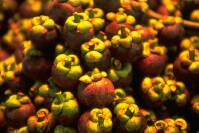 One
of the premier fruits of the tropics is the Mangosteen (garcinia mangostona).
It has a purple skin and 1/2 inch thick rind encasing a segmented, pearly white
luminous center resembling a peeled tangerine. The rind is discarded and the
luscious center is eaten fresh. Its flavor is sweet and tart, and the pulp melts
onto your tongue. Everyone likes the Mangosteen on the first try, and many feel
it is the finest fruit in the world.
One
of the premier fruits of the tropics is the Mangosteen (garcinia mangostona).
It has a purple skin and 1/2 inch thick rind encasing a segmented, pearly white
luminous center resembling a peeled tangerine. The rind is discarded and the
luscious center is eaten fresh. Its flavor is sweet and tart, and the pulp melts
onto your tongue. Everyone likes the Mangosteen on the first try, and many feel
it is the finest fruit in the world.
 "Like
fine French custard passed through a sewer pipe" is part of a description
of Durian (durio zibethinus) written by an early
Dutch traveler. Undeniably, the Durian is the most controversial of tropical
Asian fruits and one of the most beloved. In fact, the extreme value placed upon
Durian is a phenomenon difficult for Westerners to comprehend. Select varieties
are expensive. Fruits range from 6" to 10" long and can weigh up to
ten pounds. The rind is covered with very sharp spines and the fruit is carried
by the stem or by a string to avoid manual handling of the fruit. Inside each
durian are five sections with one to several seeds encased within a cream or
yellow-colored aromatic, custard-like pulp. Flavor is intriguing and difficult
to describe. A custard with almond, onion and cream cheese might begin to
describe this wonderful fruit. The fragrance of Durian is another matter---a
mixture of pungent, penetrating smell of garlic, sulfur, rotten onions and
strongly-flavored cheese. So strong is the smell of this exquisite fruit that it
is forbidden in hotels, restaurants and taxis even in communities most favoring
it. A single fruit opened covertly in a hotel room is quickly known in the
entire hotel.
"Like
fine French custard passed through a sewer pipe" is part of a description
of Durian (durio zibethinus) written by an early
Dutch traveler. Undeniably, the Durian is the most controversial of tropical
Asian fruits and one of the most beloved. In fact, the extreme value placed upon
Durian is a phenomenon difficult for Westerners to comprehend. Select varieties
are expensive. Fruits range from 6" to 10" long and can weigh up to
ten pounds. The rind is covered with very sharp spines and the fruit is carried
by the stem or by a string to avoid manual handling of the fruit. Inside each
durian are five sections with one to several seeds encased within a cream or
yellow-colored aromatic, custard-like pulp. Flavor is intriguing and difficult
to describe. A custard with almond, onion and cream cheese might begin to
describe this wonderful fruit. The fragrance of Durian is another matter---a
mixture of pungent, penetrating smell of garlic, sulfur, rotten onions and
strongly-flavored cheese. So strong is the smell of this exquisite fruit that it
is forbidden in hotels, restaurants and taxis even in communities most favoring
it. A single fruit opened covertly in a hotel room is quickly known in the
entire hotel.
Durian legends abound in Asia. It is widely held as an aphrodisiac. It is
referred to as a "heating" fruit that causes the body to feel warm.
Over consumption is said to be balanced by eating a "cooling" fruit
like the Mangosteen or the Wax Jambu (szygium), a small bell-shaped, red
or pink fruit, with a crisp white interior and mild flavor. A commonly held
belief is that drinking alcoholic beverages after eating durian can cause
illness or death. I have seen many test this belief but no one succumbed. Those
lucky enough to try durian soon cultivate a taste for its luscious flavor and
shortly find the odor only a tantalizing invitation to this exquisite southeast
Asian delicacy.
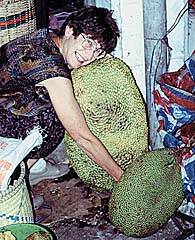 Jackfruit
(artocarpus heterophyllus) is very common in tropical Asia, being the
largest cultivated tree fruit in the world. It can weigh as much as 70 pounds.
Looking like a watermelon dressed in crocodile skin, it is easy to spot. Of
course, few people need a 70-pound fruit, so it is sold in pieces. Jackfruit has
a central core from which radiate chestnut-sized seeds each of which is
enveloped in a layer of sweet chewy pulp. It might be described as cantaloupe
combined with banana and "Juicy Fruit" gum. It should not be missed
and is often sold skewered on a bamboo splinter in the market for immediate
consumption.
Jackfruit
(artocarpus heterophyllus) is very common in tropical Asia, being the
largest cultivated tree fruit in the world. It can weigh as much as 70 pounds.
Looking like a watermelon dressed in crocodile skin, it is easy to spot. Of
course, few people need a 70-pound fruit, so it is sold in pieces. Jackfruit has
a central core from which radiate chestnut-sized seeds each of which is
enveloped in a layer of sweet chewy pulp. It might be described as cantaloupe
combined with banana and "Juicy Fruit" gum. It should not be missed
and is often sold skewered on a bamboo splinter in the market for immediate
consumption.
Chempedak (artocarpus integer) looks like a smaller version of the
jackfruit. Although similar in anatomy, the chempedak is smaller with smoother
skin, and has a stronger aroma approaching that of durian. It, too, seems to be
a "heating" fruit. Like durian, the chempedak is delicious once a
taste for it is acquired. But your first encounter could be challenging.
Pummelo (citrus grandis) is the largest commonly cultivated citrus
fruit in the world. Grown throughout the hot, humid Asian tropics, the Pummelo
reaches its zenith in the swampy tidal deltas of Thailand. In the 1700's, the
pummelo was taken to the great mixing bowl of the Caribbean, and, generations
later, the pummelo gave rise to the grapefruit. Perhaps the best way to describe
pummelo to Americans is that it is similar to a grapefruit without the sour and
bitter taste. Flesh color, like grapefruit, can be white, green, red or pink.
After the thick rind is peeled away, the large leathery segments are opened and
the juice vesicles are eaten with the fingers. Pummelos are very popular. They
may appear in the market when they are not quite ripe. Often this occurs prior
to Chinese holidays due to its role as a traditional symbol to gift. Pummelo is
a citrus fruit and is more familiar to westerners and, therefore, more quickly
appreciated.
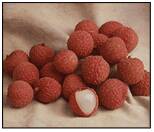 Closely
related and among the most beloved fruits in Asia are the Lychee (litchi
chinensis), Longan (euphoria longana), Rambutan (nephelium
lappaceum) and Pulisan (nephelium mutabile). The lychee and the
longan are actually grown in the subtropical zone between the tropic and the
temperate regions, originating in southern China and northern Thai, Africa,
India, and Florida.
Closely
related and among the most beloved fruits in Asia are the Lychee (litchi
chinensis), Longan (euphoria longana), Rambutan (nephelium
lappaceum) and Pulisan (nephelium mutabile). The lychee and the
longan are actually grown in the subtropical zone between the tropic and the
temperate regions, originating in southern China and northern Thai, Africa,
India, and Florida.
Florida's emerging lychee and longan industry is expanding rapidly. The
lychee fruit is about 1 1/2" long and is covered with a thin red, rough,
brittle and leathery skin that encases a sphere of translucent white pulp with
the texture of a peeled grape and a succulent sweet flesh. A single large brown
seed easily slips from within the fruit pulp. The longan has light brown skin
and is smoother and more round than lychee. It has a translucent gray pulp
surrounding a round seed which is easy to spit out. Both are eaten fresh and
dried and are among China's most beloved fruits. Although they grow in the
cooler subtropics, imported fruits are found at larger markets in the extreme
Asian tropics as well. The tropical cousins to the lychee and longan are the
rambutan, pulisan, and the Mata Kuching (Malay for cat's eye). Rambutan (a Malay
word meaning hairy lychee) is very much like lychee but its rind is covered with
long flexible prickles. Its color ranges from dark red to bright yellow. Unlike
the lychee, its pulp often clings to the seed and makes eating more difficult.
Pulisan is less widely known but is superior to the rambutan in quality. It is
covered with thick blunt spines and varies in color from red to purple, black or
green. Mata Kuching from Malaysia and Indonesia is a smaller tropical form of
the Longan. All of these fruits are immediately enjoyed upon their first
encounter and are highly recommended.
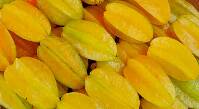 Carambola
(averrhoa carambola) or "Star Fruit," can be very sour, bland
or mildly sweet according to ripeness and variety. In most markets, dark yellow
fruits will be sweet and pleasant for eating fresh. Green ones are sour and are
used for cooking and making pickles. Extremely sour varieties are high in oxalic
acid and have been used to clean the tarnish from brassware. The fruit is sliced
to make five pointed star shaped sections. Carambola is now grown in South
Florida commercially and is available in U.S. markets. A close relative to the
Carambola is the Bilimbi (averrhoa bilimbi) which looks like a green
pickle and is used in curries and to make pickles.
Carambola
(averrhoa carambola) or "Star Fruit," can be very sour, bland
or mildly sweet according to ripeness and variety. In most markets, dark yellow
fruits will be sweet and pleasant for eating fresh. Green ones are sour and are
used for cooking and making pickles. Extremely sour varieties are high in oxalic
acid and have been used to clean the tarnish from brassware. The fruit is sliced
to make five pointed star shaped sections. Carambola is now grown in South
Florida commercially and is available in U.S. markets. A close relative to the
Carambola is the Bilimbi (averrhoa bilimbi) which looks like a green
pickle and is used in curries and to make pickles.
Langsat (lansium domesticum) is a wonderful little fruit about 1
1/2" long. It hangs in bunches. The thin tan colored skin is easily peeled
to reveal a pearly sectioned interior like a tangerine. One or more green seeds
may be present. Duku is another variety of Langsat and is also held in high
esteem. The flavor of both is like a sweetened non-bitter grapefruit with a
grape texture.
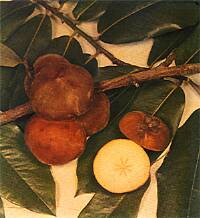 Highly
regarded in its homeland, the Philippines, the Mabolo or Velvet Apple (diospyrus
philippensis) achieves only moderate fanfare elsewhere in the Asian tropics.
This persimmon relative is the size and shape of a tomato with a beautiful
copper fuzzy skin encasing a cream-colored, mealy, slightly dry sweet pulp. In
the market, fruits often have had the fuzz rubbed off of the skin yielding a
brick red color.
Highly
regarded in its homeland, the Philippines, the Mabolo or Velvet Apple (diospyrus
philippensis) achieves only moderate fanfare elsewhere in the Asian tropics.
This persimmon relative is the size and shape of a tomato with a beautiful
copper fuzzy skin encasing a cream-colored, mealy, slightly dry sweet pulp. In
the market, fruits often have had the fuzz rubbed off of the skin yielding a
brick red color.
Bael Fruit (aegle marmelos) is native to and most favored in India and
Sri Lanka. It is larger than a baseball and has a very hard shell. Inside the
gummy pulp is like a combination of citrus oil and flower with a citrus
fragrance. It is eaten with palm sugar at breakfast. The trifoliate leaf has a
special significance to Hindus and is associated with Shiva. Trees and plants
are often found around Hindu temples.
Mango (mangifera indica) is one of the most widely eaten fruits in the
tropical world. Originating from India to the Philippines, most mangos in
tropical Asia are not the brightly colored varieties found in the U.S. but are
slim, pale green or yellow. Usually eaten when still slightly green, they are
excellent although perhaps different from the mangos you have tried in the U.S.
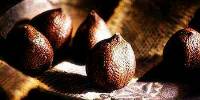 A
wooden spinning top covered with snake skin is a good description of the Salak
Palm fruit (Zalaccia edulis). Fruit of a small thorny palm with a crisp
cream colored dry flesh and an acidic flavor, it can be quite refreshing.
A
wooden spinning top covered with snake skin is a good description of the Salak
Palm fruit (Zalaccia edulis). Fruit of a small thorny palm with a crisp
cream colored dry flesh and an acidic flavor, it can be quite refreshing.
Travelers are sometimes reluctant to drink anything but bottled drinks. A
good, safe and nutritious alternative in the native market is Coconut Water. No
matter where a coconut grows, the water within the center of the nut is pure and
safe. Vendors selling drinking nuts will open them for you and even give you a
straw. After the water is consumed in a coconut, the shell is broken open and
the immature, jelly-like meat is scraped out and eaten (it is called "spoon
meat"). A pocket knife is useful to peel fresh fruits which will be safe to
eat. Of course the outside skin of any fruit might be avoided by the traveler
unless you can wash it off in chlorinated water at your hotel.
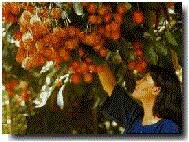 Rambutans
are a deep crimson or bright yellow. You open the fruit by splitting the tough
skin with a thumbnail and peeling it off. Or you can draw a knife around its
middle and pull the top off to reveal a lovely firm white fruit in its own
miniature egg cup that's easy to hold or hand to a friend. In size and taste,
the rambutan most closely resembles the lychee. To eat, pop the rambutan
whole into your mouth and chew your way around the single seed that you'll find
in the centre.
Rambutans
are a deep crimson or bright yellow. You open the fruit by splitting the tough
skin with a thumbnail and peeling it off. Or you can draw a knife around its
middle and pull the top off to reveal a lovely firm white fruit in its own
miniature egg cup that's easy to hold or hand to a friend. In size and taste,
the rambutan most closely resembles the lychee. To eat, pop the rambutan
whole into your mouth and chew your way around the single seed that you'll find
in the centre.
Tasting fruits throughout the market is a great way to absorb some of the
fundamental aspects of Asia. Don't be shy, ask about what you see. Vendors are
usually pleased to share your first experience with their fruits. Let them show
you the way to eat them. Be positive and inquisitive and you will make friends
and enrich your visit.
| Back to Hotel
Main Menu | More
Kuching Virtual Tours |
 One
of the premier fruits of the tropics is the Mangosteen (garcinia mangostona).
It has a purple skin and 1/2 inch thick rind encasing a segmented, pearly white
luminous center resembling a peeled tangerine. The rind is discarded and the
luscious center is eaten fresh. Its flavor is sweet and tart, and the pulp melts
onto your tongue. Everyone likes the Mangosteen on the first try, and many feel
it is the finest fruit in the world.
One
of the premier fruits of the tropics is the Mangosteen (garcinia mangostona).
It has a purple skin and 1/2 inch thick rind encasing a segmented, pearly white
luminous center resembling a peeled tangerine. The rind is discarded and the
luscious center is eaten fresh. Its flavor is sweet and tart, and the pulp melts
onto your tongue. Everyone likes the Mangosteen on the first try, and many feel
it is the finest fruit in the world.
 ASIAN
EXOTIC FRUITS - One of the best places to experience Asian culture is
in its markets. There, a traveler can glimpse a segment of everyday life, not
through the isolating insult of a telephoto lens, but through eye to eye
contact. Most of the time, patience and humor are all that is needed to guide
you through a market. Meats, fishes, spices, herbs and fruits are on display, so
too is the local costume, culture and fabric of the everyday community.
ASIAN
EXOTIC FRUITS - One of the best places to experience Asian culture is
in its markets. There, a traveler can glimpse a segment of everyday life, not
through the isolating insult of a telephoto lens, but through eye to eye
contact. Most of the time, patience and humor are all that is needed to guide
you through a market. Meats, fishes, spices, herbs and fruits are on display, so
too is the local costume, culture and fabric of the everyday community.
 "Like
fine French custard passed through a sewer pipe" is part of a description
of
"Like
fine French custard passed through a sewer pipe" is part of a description
of  Jackfruit
(artocarpus heterophyllus) is very common in tropical Asia, being the
largest cultivated tree fruit in the world. It can weigh as much as 70 pounds.
Looking like a watermelon dressed in crocodile skin, it is easy to spot. Of
course, few people need a 70-pound fruit, so it is sold in pieces. Jackfruit has
a central core from which radiate chestnut-sized seeds each of which is
enveloped in a layer of sweet chewy pulp. It might be described as cantaloupe
combined with banana and "Juicy Fruit" gum. It should not be missed
and is often sold skewered on a bamboo splinter in the market for immediate
consumption.
Jackfruit
(artocarpus heterophyllus) is very common in tropical Asia, being the
largest cultivated tree fruit in the world. It can weigh as much as 70 pounds.
Looking like a watermelon dressed in crocodile skin, it is easy to spot. Of
course, few people need a 70-pound fruit, so it is sold in pieces. Jackfruit has
a central core from which radiate chestnut-sized seeds each of which is
enveloped in a layer of sweet chewy pulp. It might be described as cantaloupe
combined with banana and "Juicy Fruit" gum. It should not be missed
and is often sold skewered on a bamboo splinter in the market for immediate
consumption.
 Closely
related and among the most beloved fruits in Asia are the Lychee (litchi
chinensis), Longan (euphoria longana), Rambutan (nephelium
lappaceum) and Pulisan (nephelium mutabile). The lychee and the
longan are actually grown in the subtropical zone between the tropic and the
temperate regions, originating in southern China and northern Thai, Africa,
India, and Florida.
Closely
related and among the most beloved fruits in Asia are the Lychee (litchi
chinensis), Longan (euphoria longana), Rambutan (nephelium
lappaceum) and Pulisan (nephelium mutabile). The lychee and the
longan are actually grown in the subtropical zone between the tropic and the
temperate regions, originating in southern China and northern Thai, Africa,
India, and Florida. Carambola
(averrhoa carambola) or "Star Fruit," can be very sour, bland
or mildly sweet according to ripeness and variety. In most markets, dark yellow
fruits will be sweet and pleasant for eating fresh. Green ones are sour and are
used for cooking and making pickles. Extremely sour varieties are high in oxalic
acid and have been used to clean the tarnish from brassware. The fruit is sliced
to make five pointed star shaped sections. Carambola is now grown in South
Florida commercially and is available in U.S. markets. A close relative to the
Carambola is the Bilimbi (averrhoa bilimbi) which looks like a green
pickle and is used in curries and to make pickles.
Carambola
(averrhoa carambola) or "Star Fruit," can be very sour, bland
or mildly sweet according to ripeness and variety. In most markets, dark yellow
fruits will be sweet and pleasant for eating fresh. Green ones are sour and are
used for cooking and making pickles. Extremely sour varieties are high in oxalic
acid and have been used to clean the tarnish from brassware. The fruit is sliced
to make five pointed star shaped sections. Carambola is now grown in South
Florida commercially and is available in U.S. markets. A close relative to the
Carambola is the Bilimbi (averrhoa bilimbi) which looks like a green
pickle and is used in curries and to make pickles.
 Highly
regarded in its homeland, the Philippines, the Mabolo or Velvet Apple (diospyrus
philippensis) achieves only moderate fanfare elsewhere in the Asian tropics.
This persimmon relative is the size and shape of a tomato with a beautiful
copper fuzzy skin encasing a cream-colored, mealy, slightly dry sweet pulp. In
the market, fruits often have had the fuzz rubbed off of the skin yielding a
brick red color.
Highly
regarded in its homeland, the Philippines, the Mabolo or Velvet Apple (diospyrus
philippensis) achieves only moderate fanfare elsewhere in the Asian tropics.
This persimmon relative is the size and shape of a tomato with a beautiful
copper fuzzy skin encasing a cream-colored, mealy, slightly dry sweet pulp. In
the market, fruits often have had the fuzz rubbed off of the skin yielding a
brick red color.
 A
wooden spinning top covered with snake skin is a good description of the Salak
Palm fruit (Zalaccia edulis). Fruit of a small thorny palm with a crisp
cream colored dry flesh and an acidic flavor, it can be quite refreshing.
A
wooden spinning top covered with snake skin is a good description of the Salak
Palm fruit (Zalaccia edulis). Fruit of a small thorny palm with a crisp
cream colored dry flesh and an acidic flavor, it can be quite refreshing.
 Rambutans
Rambutans